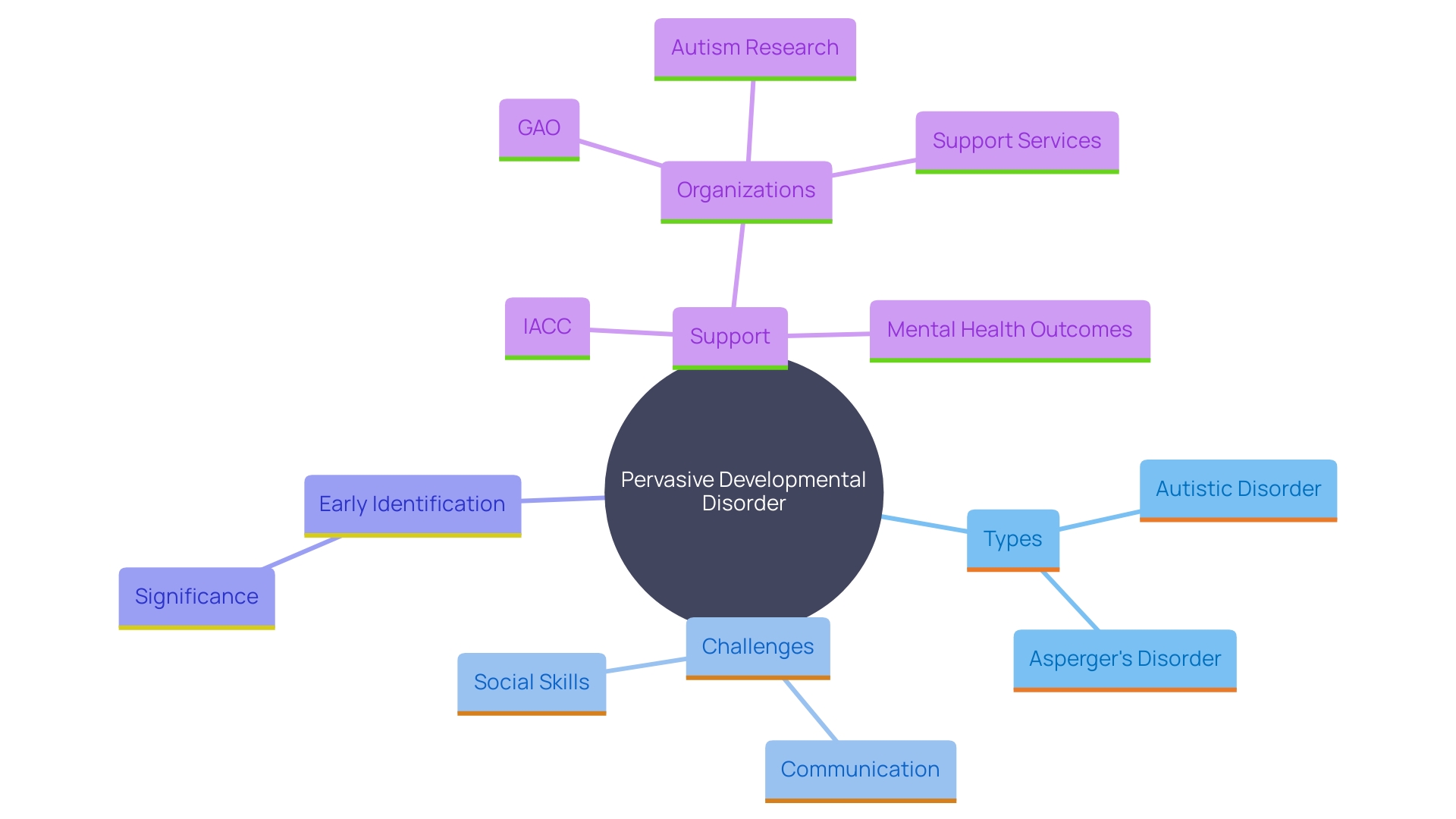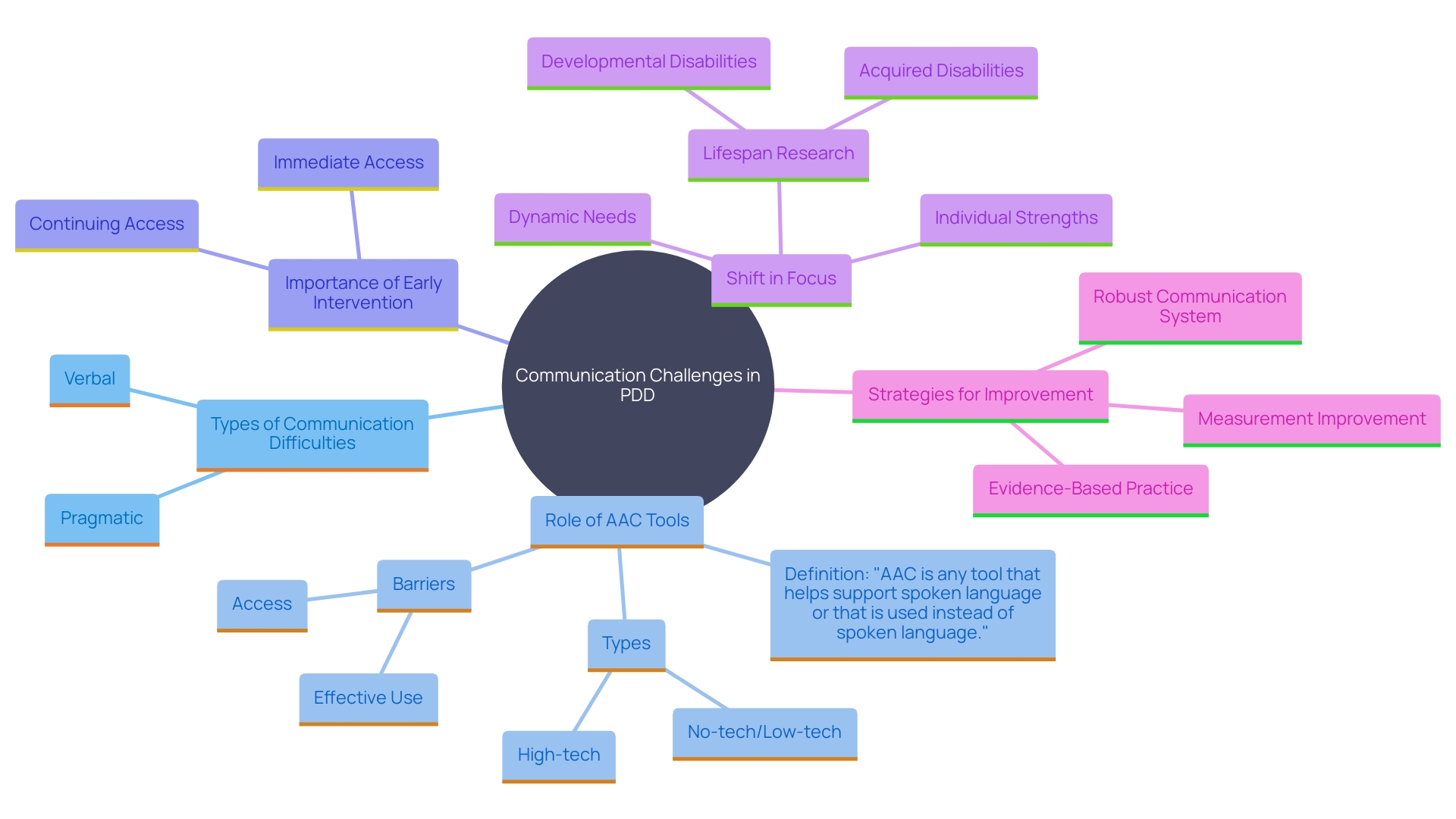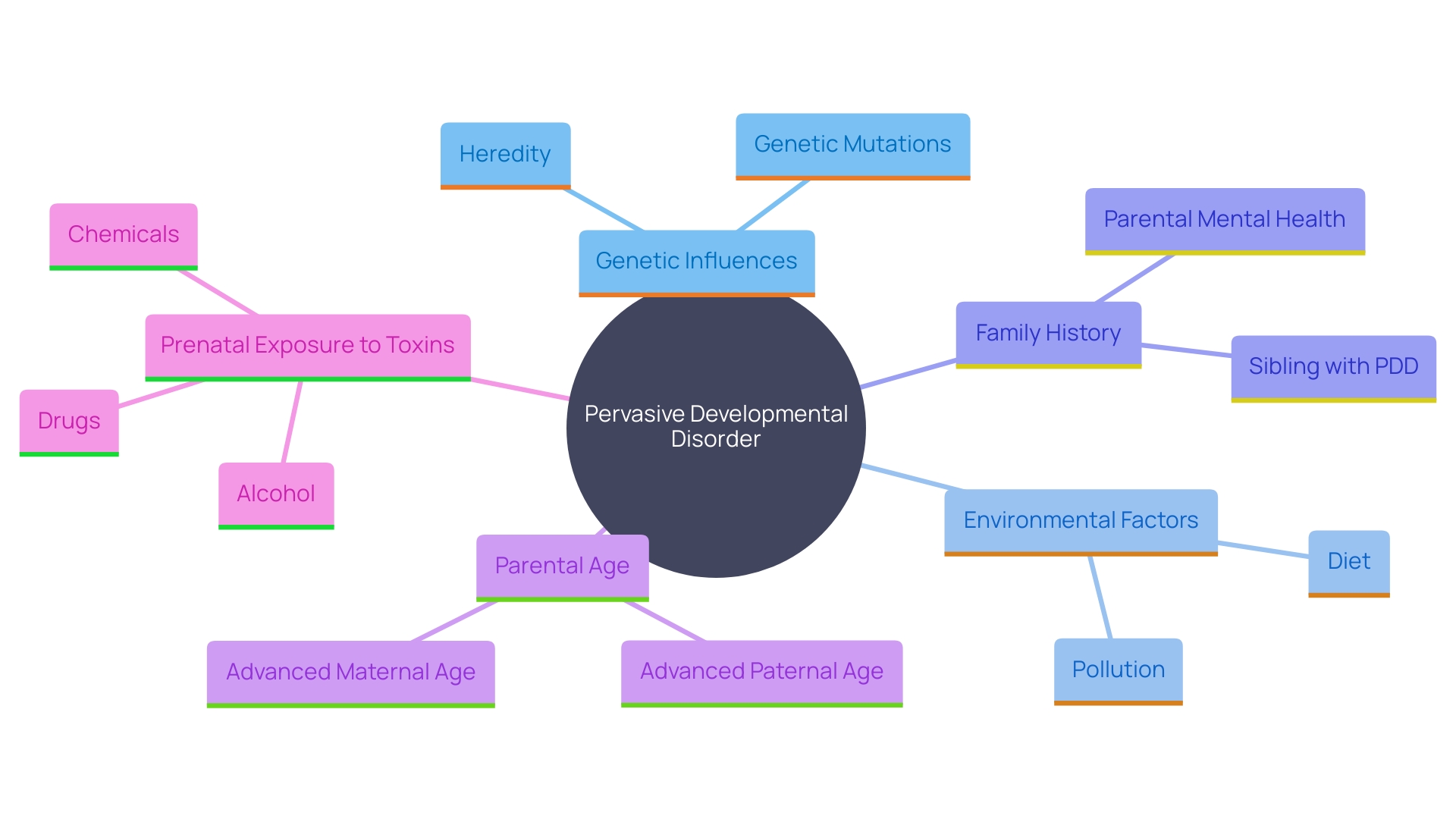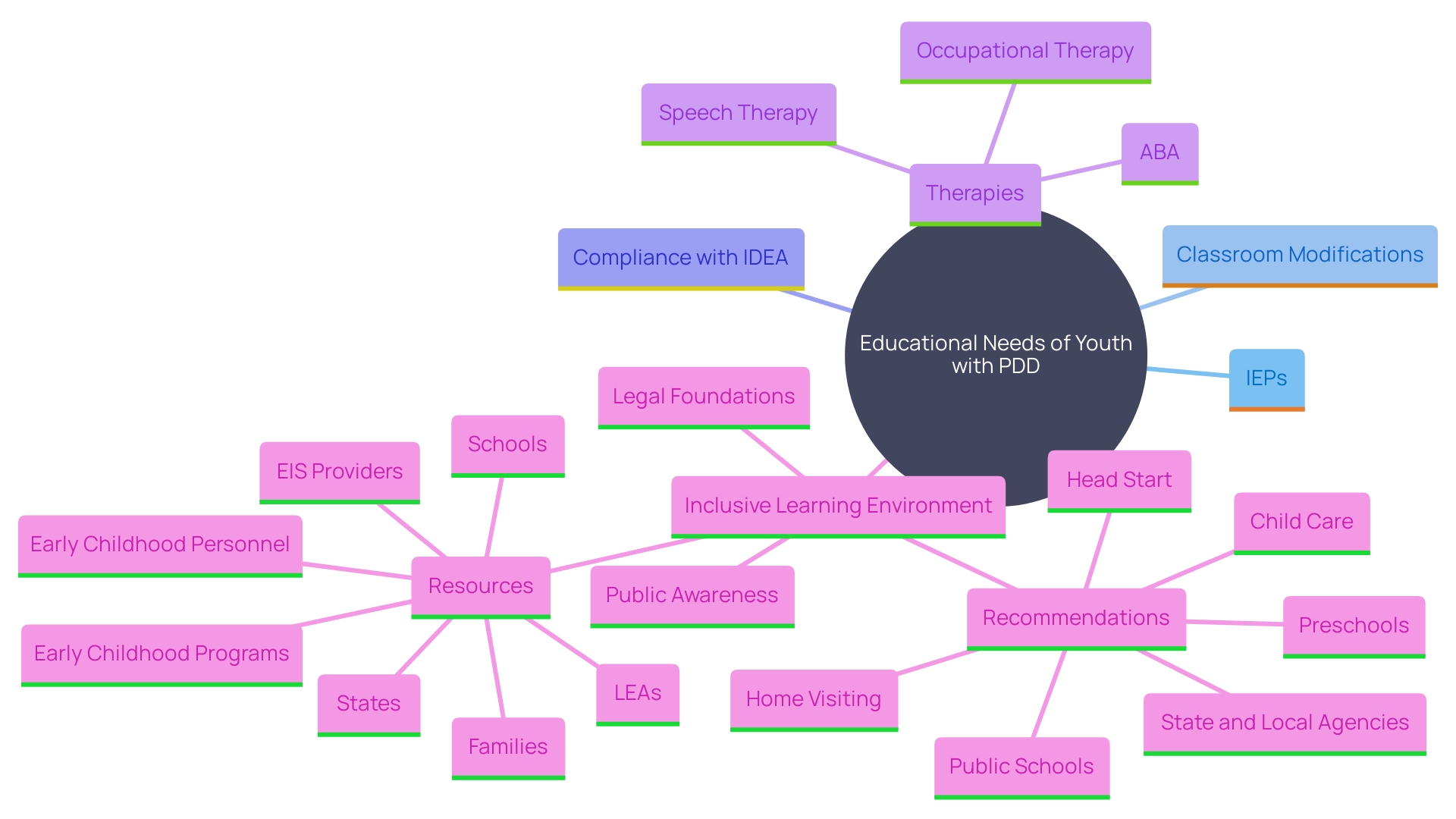Introduction
Navigating the complexities of Pervasive Developmental Disorder (PDD) can be challenging for families, educators, and caregivers. PDD encompasses a range of developmental conditions, including Autistic Disorder, Asperger's Disorder, and PDD-NOS (Pervasive Developmental Disorder-Not Otherwise Specified), which significantly impact social interaction, communication, and behavior. Understanding these conditions is crucial for early identification and the provision of appropriate support to ensure the well-being and development of affected children.
Emerging research highlights the heightened prevalence of mental health issues among individuals with neurodevelopmental conditions, emphasizing the need for tailored interventions and integrated care approaches. Additionally, organizations like the Interagency Autism Coordinating Committee (IACC) are pivotal in enhancing research and services, ensuring diverse perspectives and expertise are reflected in policy recommendations.
This article delves into the key characteristics of PDD, including social interaction challenges, communication difficulties, and restricted and repetitive behaviors. It also explores the causes and risk factors associated with PDD, the importance of early detection and intervention, and effective support strategies. By fostering a comprehensive understanding and addressing the unique needs of children with PDD, we can create inclusive environments that promote their development and well-being.
What is Pervasive Developmental Disorder (PDD)?
Pervasive Developmental Disorder (PDD) refers to a spectrum of developmental conditions that affect interpersonal interaction, communication, and behavior. This umbrella term includes Autistic Disorder, Asperger's Disorder, and PDD-NOS (Pervasive Developmental Disorder-Not Otherwise Specified). Individuals with PDD often face challenges in developing social skills, communicating effectively, and may exhibit restrictive or repetitive behaviors.
Understanding PDD is essential for early identification and support of affected youth. The National Academies of Sciences, Engineering, and Medicine emphasize the importance of recognizing both the unmet needs and the strengths of youth with disabilities, ensuring fair opportunities for their development.
Recent studies indicate that mental health issues such as depression and suicidality are more prevalent among individuals with neurodevelopmental conditions, including PDD. Despite this, these groups have historically been excluded from mental health research, resulting in fewer tailored treatment options. Experts like Jessica Schwartzman and Kristen Berg are working to bridge this gap by developing community-based interventions and integrated care approaches to address the mental health needs of those with neurodevelopmental conditions.
In the United States, the Interagency Autism Coordinating Committee (IACC) plays a crucial role in enhancing autism research and services. Comprising officials from various federal agencies, autistic adults, family members, and advocates, the IACC aims to improve coordination and communication across the federal government, reflecting diverse perspectives and expertise in its recommendations.
As Dr. David Offord once emphasized, establishing a just and encouraging atmosphere for youngsters with disabilities is essential. The involvement and well-being of these young individuals in their daily routines are essential to their mental health and social fairness. Ensuring that caregivers have the necessary resources to support their offspring is equally important for promoting healthy development and family well-being.

Key Characteristics of PDD
Children with Pervasive Developmental Disorder (PDD) often exhibit a range of characteristics that vary in severity, impacting their daily lives and interactions. Interpersonal difficulties are common, including challenges in understanding cues and forming relationships. These young individuals might find it hard to engage in typical social interactions, which can hinder their ability to build meaningful connections with peers.
Communication challenges are also prevalent, with some individuals experiencing delayed speech development or atypical use of language. This can manifest in various ways, such as struggling to follow conversations, misunderstanding what others say, or rapidly forgetting spoken information. These communication barriers often necessitate additional support in educational settings to ensure these individuals can access quality education effectively.
Furthermore, many young individuals with PDD participate in restricted and repetitive behaviors. These can include strict adherence to routines, rituals, or intense interests in specific topics. While these behaviors can provide comfort and predictability for the young one, they can also be limiting and interfere with their ability to adapt to new situations or changes in their environment.
Understanding and addressing these characteristics require a comprehensive approach that focuses on the individual's strengths and how to modify their environment to support their success. By recognizing the unique challenges and needs of children with PDD, parents, educators, and caregivers can work together to create supportive and inclusive environments that promote their development and well-being.
Social Interaction Challenges in PDD
Social interaction is a critical area of difficulty for individuals with Pervasive Developmental Disorder (PDD). Children with PDD often struggle to initiate or maintain conversations, interpret body language, or respond appropriately to interpersonal situations. They may gravitate towards solitary play rather than engaging in group activities and find it challenging to understand others' perspectives. These community challenges can lead to feelings of isolation and frustration. Therefore, targeted interpersonal skills training is essential.
As pointed out by Dr. David Offord, ensuring equitable opportunities for youngsters with disabilities in all areas of life, including interpersonal engagement, is crucial for their mental well-being. Engagement and support in school, home, and leisure activities significantly contribute to their overall well-being. Organizations like the Interagency Autism Coordinating Committee (IACC) emphasize the importance of coordinated efforts in autism research and services to improve outcomes for individuals on the spectrum. By acknowledging and tackling the communal needs of youth with PDD, we can promote more inclusive communities where every individual has the opportunity to flourish.
Communication Difficulties in PDD
Communication challenges in PDD can manifest in various forms, significantly impacting interpersonal interactions and daily life. For some children, verbal communication may be minimal or non-existent. Others might acquire language skills but face difficulties with pragmatic language, such as interpreting jokes or idiomatic expressions. These hurdles can obstruct effective expression of needs and emotions, leading to additional barriers in social interactions.
Augmentative and Alternative Communication (AAC) tools, ranging from no-tech options like printed communication boards to high-tech speech-generating devices, can offer essential assistance. These tools help bridge the communication gap, allowing young individuals to express themselves more effectively. However, access to these tools and their effective use can be challenging.
Research underscores the importance of early and continuous intervention to establish a robust communication system. A virtual workshop held on January 24-25, 2023, highlighted the need for ongoing research to improve communication strategies across the lifespan. 'Involving experts, researchers, and individuals with personal experiences can propel the creation of evidence-based practices that enhance independent and meaningful communication.'.
One expert emphasizes, "The focus on the gap is important because it shifts the emphasis from an individual's problem to the person's strengths and how to change demands of the context to ensure their success." This perspective is crucial in shaping effective communication strategies that empower individuals with PDD to navigate their social environments more confidently.

Restricted and Repetitive Behaviors in PDD
Restricted and repetitive behaviors are hallmark features of Pervasive Developmental Disorder (PDD), including autism spectrum disorders. These behaviors often manifest as repetitive movements like hand-flapping or rocking, and a strong insistence on maintaining sameness in routines or environments. Children with PDD may also develop intense interests in specific subjects, which can dominate their conversations and activities.
Comprehending these behaviors is crucial for parents and caregivers to offer suitable assistance and structure. As Dr. David Offord, a renowned psychiatrist specializing in youth, emphasized, recognizing the unique needs and strengths of individuals with disabilities is a cornerstone of ensuring equity and mental health. Caregivers must be equipped with resources to support their offspring's development and family well-being.
Scientific research underscores the importance of a supportive environment in promoting healthy development. For example, involving young individuals in diverse and encouraging tasks at home, school, and during free time is essential. Establishing a supportive atmosphere aids in alleviating chronic stress and encourages improved results for young individuals with PDD.
Moreover, the National Academies of Sciences, Engineering, and Medicine highlight the significance of providing high-quality, objective advice on health matters. 'Their conferences and workshops serve as essential platforms for discussing the latest scientific findings and strategies for supporting youth with developmental disorders.'. This collective effort aims to ensure that caregivers have access to the best possible information and resources to support their dependents.
In conclusion, by understanding and addressing these restricted and repetitive behaviors, parents and caregivers can create a more supportive and structured environment that promotes the well-being and development of youth with PDD.
Causes and Risk Factors of PDD
The precise origins of Pervasive Developmental Disorder (PDD) remain elusive, but studies indicate a mix of genetic and environmental influences may play a role. For instance, a family history of autism spectrum disorders significantly raises the likelihood of PDD. Additionally, advanced parental age has been pinpointed as a contributing factor. Prenatal exposure to certain environmental toxins is another identified risk factor. Recognizing these elements is crucial as it facilitates early detection and the implementation of early intervention strategies, which are vital for improving outcomes.

Importance of Early Detection and Intervention
Timely identification and action are crucial for improving results for youngsters with PDD. Recognizing the signs of PDD early enables the initiation of customized therapies and support strategies that foster improvements in communication, social skills, and behavior. These early interventions can profoundly impact a young person's developmental path, significantly increasing their potential to lead a fulfilling life. Reinforcing the legal foundations supporting inclusion and updating recommendations for State and local agencies that implement Individuals with Disabilities Education Act (IDEA) programs are key steps. Resources for States, Leas, EIS providers, early childhood programs, schools, and families play a significant role in supporting high-quality individualized programming and the inclusion of individuals with disabilities. By establishing the expectation of ongoing inclusion from early development through elementary school, we can ensure that individuals with PDD receive the support they require during these vital early years. This approach aligns with the broader efforts of the autism community and federal advisory committees like the IACC, which aim to improve coordination and communication across the government and work in partnership with families and advocates.
Support Strategies for Individuals with PDD
Assisting young individuals with Pervasive Developmental Disorder (PDD) necessitates a thorough, multi-dimensional method that combines different therapeutic strategies. Behavioral therapy, speech therapy, and social skills training are essential components. Parents and caregivers can foster a structured environment tailored to their offspring's unique needs, promoting both comfort and independence. Working together with teachers and therapists is vital to ensure uniformity across various environments, thereby improving the overall assistance network. The Individuals with Disabilities Education Act (IDEA) emphasizes the importance of inclusive education, reinforcing the need for high-quality individualized programs in early childhood settings. This includes utilizing resources from state and local agencies, early intervention service providers, and educational institutions to assist youngsters with disabilities. Moreover, tools like Augmentative and Alternative Communication (AAC) systems can play a significant role in facilitating effective communication, ensuring individuals with PDD have the means to express themselves and engage with others.
Educational Accommodations and Therapies for PDD
Educational environments must adjust to fulfill the distinct requirements of youth with PDD by integrating a range of strategies and resources. Individualized Education Plans (IEPs) play a crucial role in tailoring educational approaches to each student's specific requirements. These plans ensure that young individuals receive the appropriate level of instruction and intervention, as optimal dosage is essential for progress without causing disengagement.
Specialized teaching methods and classroom modifications further assist these students. For instance, creating an inclusive learning environment that adheres to the recommendations set forth by the Individuals with Disabilities Education Act (IDEA) can make a significant impact. This includes not just public schools but also early childhood programs like Head Start and home visiting services, emphasizing the importance of high-quality individualized programming from the earliest ages.
Therapies such as Applied Behavior Analysis (ABA), occupational therapy, and speech therapy offer essential skills and strategies. ABA can help manage behavior and enhance learning, while occupational and speech therapies address fine motor skills and communication challenges, respectively. These interventions are vital for helping children succeed both academically and socially, reinforcing the legal and educational framework that supports the inclusion and development of children with disabilities.

Conclusion
Understanding Pervasive Developmental Disorder (PDD) is crucial for fostering an inclusive environment for affected children. The spectrum of PDD, which includes conditions such as Autistic Disorder and Asperger's Disorder, presents distinct challenges in social interaction, communication, and behavior. Early identification and tailored interventions are essential for addressing these challenges and promoting the well-being of children with PDD.
Key characteristics of PDD, including social difficulties, communication barriers, and restricted behaviors, necessitate a comprehensive approach from parents, educators, and caregivers. By recognizing these unique needs and implementing effective support strategies, individuals can create nurturing environments that promote development and enhance quality of life. Furthermore, understanding the underlying causes and risk factors associated with PDD aids in early detection, which is vital for initiating appropriate interventions.
The role of organizations like the Interagency Autism Coordinating Committee (IACC) is pivotal in improving research and services for individuals with PDD. Their efforts, alongside community-based interventions, emphasize the importance of integrated care approaches to address the mental health needs of affected individuals. By fostering collaboration among families, educators, and advocates, a more supportive and inclusive society can be created, ensuring that children with PDD have the opportunity to thrive and reach their full potential.




